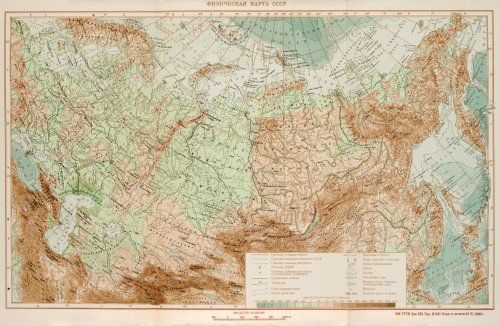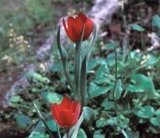 |
QUICK SEARCH
MO PROJECTS:
Africa
Asia/Pacific
Mesoamerica
North America
South America
General Taxonomy
Photo Essays
Training in Latin
America
MO RESEARCH:
Wm. L. Brown Center
Bryology
GIS
Graduate Studies
Research Experiences
for Undergraduates
Imaging Lab
Library
MBG Press
Publications
Climate Change
Catalog Fossil Plants
MO DATABASES:
W³MOST
Image Index
Rare Books
Angiosperm
Phylogeny
Res Botanica
All Databases
INFORMATION:
What's New?
People at MO
Visitor's Guide
Herbarium
Jobs & Fellowships
Symposium
Research Links
Site Map
Search
HISTORICAL SKETCH
Russia and other republics of the former Soviet Union (FSU), which cover vast territories across eastern Europe and northern Asia, were essentially closed to foreigners for more than 70 years. Following the 1917 Russian Revolution, this enormous area became progressively isolated from the rest of the world. Government-imposed restrictions were placed upon travel (both into and out of the FSU) and almost all other means of communication were monitored as well. Although a trickle of scientific communication was maintained throughout the years, the ability of Russian scientists and gardeners to freely interact with foreign colleagues was severely limited. Consequently, very few native Russian plants entered the world of horticulture. Today the countries of the FSU have started to open up and it is possible for botanists and amateurs from all over the world to arrange field trips. The domestication and spread of cultivated Russian plants to other parts of the world began in ancient times. The history of the first Russian plants seen in other countries can be difficult to trace, although we can reconstruct some introductions. In many countries adjacent to the FSU, Russian plants
Cultivated tulips had mysterious origin: it was known that the first tulip bulbs reached Europe in the years 1556-1560, thanks to Ogier Ghiselin de Busbecq, Emperor Ferdinand's Viennese ambassador to the Court of the Sultan in Constantinople (Fisher, 1982). It was assumed that the bulbs were dug somewhere near the city. However, attempts over many years
Obviousely then, ancestral tulips came from the Crimean city of Cafa (Feodosiya) and not from Cappadocia. This is why no botanist could locate this wild tulip in Turkey - this species simply does not occur there. A wild tulip, described as T. schrenkii, occurs in the Crimea, across southern and eastern parts of European Russia and into northwestern Kazakstan. Later, by careful herbarium investigation, Mordak (1990) concluded that T. schrenkii and T. gesneriana (Linnaeus cultivated species) one and the same. Thus Russia and its bordering territories are the natal place where this tulip occurs in nature. Tulipa gesneriana L. is the ancestor of an enormous number of cultivars, and T. schrenkii Regel is only a synonym to this name. The large-scale introduction of Russian plants to western Europe began in the eighteenth century, historically a time of botanical exploration within the country. Many expeditions were sent by the government to outlying territories of the Russian Empire such as the Caucasus, Urals, Siberia, even far-flung Kamchatka, etc. Eighteenth century Russian explorers worked in close contact with western European botanists exchanging plants. Particularly significant was the acquaintance of Russian botanists with Carolus Linnaeus (Bobrov, 1970; Shcherbakova, 1958), whose garden lay in Uppsala, Sweden. This may be why a Swedish Linnaeus was the first to describe many Russian species. The most ornamental of his species came to be cultivated in other Western European gardens. Renowned botanists and travellers (J. G. Gmelin, S. P. Krasheninnikov, G. W. Steller) sent plants and seeds to Linnaeus, as did Linnaeus pupil Johan Falk. Well known Russian plants such as Tatarian maple (Acer tataricum) and dwarf Russian almond (Amygdalus nana =Prunus tenella) originally reached Western Europe through the travails of John Falk. Linnaeus had friends not only among professional botanists, but also among other professionals who lived and travelled in many countries throughout the world. In particular, the Demidov family, owners of mines and factories in the Urals, maintained close relations with him. Three of that family, Gregory, David, and Peter, were students of Linnaeus and often sent him Russian plants from their Botanical Garden in Solikamsk. Thus, in 1748 they sent to Linnaeus the seeds of 62 species, including our well-known globeflower (Trollius asiaticus) and snakeroot (Cimicifuga foetida). In 1760, Russian imperial doctor David de Gorter sent Linnaeus a package with various medicinal plants, among which was Siberian tea (Bergenia crassifolia). This plant very rapidly won horticultural popularity in continental Europe because of its evergreen leaves. It first appeared in England in 1765, and from there it was introduced into North America. Linnaeus garden in Uppsala was full of Russian plants. A. M. Karamyshev (1744-1791), one of the Russian students, studied plants in the garden, counted 118 species from Siberia alone. Russian botanists also had contact with England. Johannes Amman (1707-1741), of the Russian Academy of Sciences, sent plants to English gentlemen such as Hans Sloane, founder of both the Chelsea Physic Garden and the British Museum. From Amman' Sloane received our beloved airy gyp or baby's breath (Gypsophila paniculata) and dramatic Tatarian honeysuckle (Lonicera tatarica). Amman also sent specimens to another English friend Peter Collinson, including larkspur (Delphinium grandiflorum) and red-barked shrub (Swida australis). Like Linnaeus, Collinson corresponded with the Demidov family and in 1756 received several packages from Gregory Demidov. He also received seeds collected by Peter Simon Pallas (1741-1811), the famous Russian botanist. Among that collections were seeds of unknown sguill, which was shortly described as Scilla siberica. Collinson in turn sent seeds of new and interesting plants to other correspondents, among them the American John Custis. As illustrated, government expeditions to Siberia introduced plants of that region into Europe. Much later, Central Asia and the Far East were similarly explored, and their plants also introduced to Europe and America. For example, many Far Eastern plants were sent to England by Carl Maximovich (1827-1891) and among them were kiwi (Actinidia kolomikta), the wonderful perennial twinleaf (Plagiorhegma dubia, =Jeffersonia dubia) and a peony (Paeonia obovata). Close contact among botanists even in the 18th century explains why many European botanists were among the first to describe Russian plants. Numerous species were named after Russian regions, cities and villages or putative origin. In those days, the plant's journeys were slow, and by the time plant material arrived at its destination the original labels had often been lost or destroyed. Lack of accurate information about plant distribution gave rise to misunderstandings and false assumptions. Some plants received names that by no means corresponded to the location of their natural habitat. For instance, the squill (Scilla siberica) does not occur in Siberia; it grows in warmer southern Russia, the Crimea, and the Caucasus. Having escaped, the plant is now naturalized in central and southern Europe. On the other hand, the candlestick lily native to eastern Siberia and the Far East was named by John Ker-Gawler in 1804 as Lilium pensylvanicum. Five years later, having recognized his mistake, he tried to correct it and renamed it L. dahuricum, after a Siberian locale. However, as ruled by our International Code of Botanical Nomenclature, the earlier name must stand. This is why this Siberian lily is called L. pensylvanicum. The majority of our currently known Russian ornamental plants came to western Europe and then to the world horticultural trade mainly through the St. Petersburg Botanical Garden. Founded by Peter the Great in 1714, the Apothecaries Ogorod (Apothecaries Garden) was initially designed to grow medicinal plants. The search for new species led subsequently to investigation of the flora of Russia and adjacent countries. Later the Apothecaries Ogorod was transformed into the Botanical Garden. The Garden played a leading role in the discovery and cultivation of indigenous plants for the next three centuries, and its botanists participated in numerous expeditions, and described the majority of the native flora of Russia. By the Garden 200 jubilee V. I. Lipsky (1913) published a book about the Garden's work including a list of 1,500 Russian species introduced from the Garden into world horticulture. This list reveals that some of these species are now neglected and could be reintroduced into horticulture. Most of this list is given in part 4. Later, in 1931, the Garden was transformed into the Komarov Botanical Institute of the Academy of Sciences, first of the USSR, now of Russia. In the 1930s this Institute began a major floristic project that resulted in the publication of the 30-volume "Flora of the USSR," (1934-1964) describing a plethora of new species. Unhappily, this treatise was available to only a narrow circle of botanists until its translation into English in 1968-1998. Because of the language barrier, many taxonomical misunderstandings have been perpetuated until this very day. This inaccessibility made the study of related plants difficult and prevented full understanding of the relationships between the flora of Russia and those of adjacent countries. In many horticultural references, authoritative floras and monographs, the geographical distributions of plants in the USSR are inaccurate and sometimes simply wrong. Ignorance of the Russian botanical literature, unavailable for so many years, caused incorrect conclusions, even in phytogeographical investigations. As a result, in even the very best garden encyclopedias, information on the geographical distribution of Russian plants is often incorrect or incomplete. Nonetheless, research in Soviet botanical gardens confirmed numerous species that could be used in horticulture, and in spite of the Iron Curtain, a few plant species did enter world horticulture. Some examples lend the wonderful impression that the Russian plants could rapidly become favorite garden plants, among them rare species in danger of extinction but now listed in the catalogues of commercial nurseries. Thus, although Iridodictyum winogradowii [=Iris winogradowii] is very rare in nature, occuring only on the slopes of Mt. Lomtismta in the Southern Transcaucasus, it is now well-known to horticulturists and especially popular in Holland and England. Thanks to the ongoing activity of the Komarov Botanical Institute, many other plants, including Chrysanthemum zawadskii [=Dendranthema zawadskii] and Scilla rosenii, have been introduced to world horticulture. It is obvious that in the near future many more Russian plants will appear in world gardening. Horticulture plays an enormously important role in the preservation of rare and endangered plant species. Making such plants available in quantity not only helps to discourage gathering them in the wild, it is also contributes directly to the preservation of the species concerned by spreading them widely in cultivation. The efforts of the Komarov Botanical Institute to develop a method and bulbs for the efficient propagation of such plants as Iridodictyum winogradowii and Scilla rosenii, are noteworthy in this regard. It is safe to conclude that the role of Russian plants in horticulture so far does not completely reflect the richness of its flora. |
||||
| ORNAMENTAL PLANTS FROM RUSSIA |
© 1995-2025 Missouri Botanical Garden, All Rights Reserved
4344 Shaw Blvd.
St. Louis, MO 63110
(314) 577-5100
Technical Support



